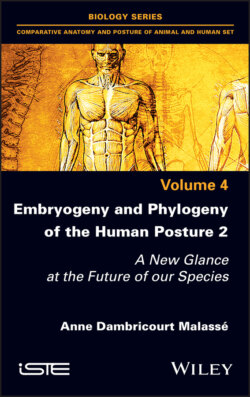Читать книгу Embryogeny and Phylogeny of the Human Posture 2 - Anne Dambricourt Malasse - Страница 10
1
The 20th Century. A New Science: Human Paleontology 1.1. Introduction
ОглавлениеThe 19th century saw the recognition of the animal and simian origin of Homo sapiens, although not without difficulty, through thought experiments due to the lack of sufficient knowledge in both paleontology and reproductive biology. The long geological periods throughout the history of the Earth and its cooling, as described by Georges Buffon, made it possible to locate fossil and current species according to lineages, or phylums, and then to link these phylums together by looking for “intermediate” fossil species. In this phylogeny of multicellular organisms, which became vertebrates with the horizontal organization of chordates, the primate lineage can be distinguished by the verticalization of the neuraxis starting from the posterior cranial base, the reduction of prognathism and an encephalization that led to Homo sapiens, the most verticalized chordate. Verticalization was the guiding thread of the problem, and the bimania (meaning two-hands in Latin) linked to this verticality was then much more significant for anthropologists, along with encephalization, then bipedalism, which was not original, being common in gibbons as well as birds. Whatever one’s opinion on the meaning of Man’s place in the animal kingdom and the history of the Earth, verticalized anatomy has not left the place assigned to it by the history of animals since Aristotle. It remains the last point on the curve of this complexification/verticalization, which was accompanied by an increase in cognitive capacities.
For prehistorians and anthropologists, Homo sapiens is characterized by articulated language and symbolic behaviors manifested by the creation of objects unrelated to primary necessities. These activities concern ornaments, engravings, paintings and sculptures; as innovations that express values, significations, they are bearers of meaning. On the eve of 19th century, the oldest Homo sapiens skeletons were still rare, but they were already associated with these productions at prehistoric periods that had nothing in common with the Adamic tradition, still well anchored in the European culture that refused the idea of a simian origin. This filiation was defended at the Muséum national d’Histoire naturelle (French National Museum of Natural History, henceforth referred to as the Muséum) in 1802 by Jean-Baptiste Lamarck, Etienne Geoffroy Saint-Hilaire and his son Isidore Geoffroy Saint-Hilaire, but 70 years later, it did not find unanimous acceptance with an interesting and strong personality, the geophysicist, physician and anthropologist Armand de Quatrefages.
